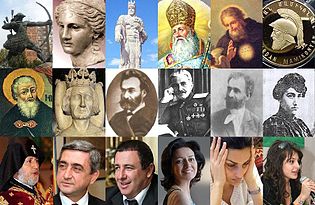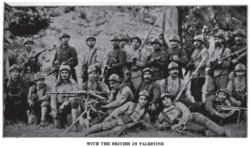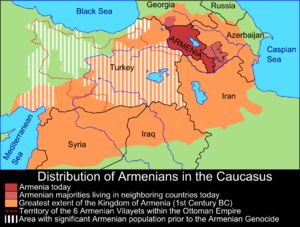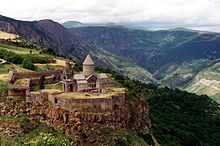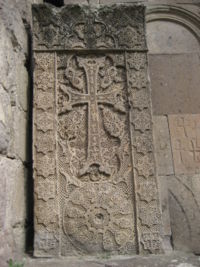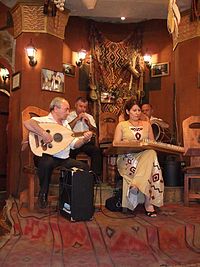- Armenians
-
This article is about Armenians as an ethnic group. For people living in Armenia, see Demographics of Armenia. Not to be confused with Arminianism.
Armenians
Հայեր1st row: Hayk • Anahit • Tigran the Great • St. Gregory the Illuminator • Mesrop Mashtots • Vartan Mamikonian
2nd row: Moses of Chorene • Levon II • Raffi (poet) • Andranik Ozanian • Hovhannes Tumanyan • Shushanik Kurghinian
3rd row: Karekin II • Serzh Sargsyan • Gagik Tsarukyan • Hasmik Papian • Siranush Andriasian • SirushoTotal population 8,000,000-12,000,000 Regions with significant populations  Armenia 3,145,000[1]
Armenia 3,145,000[1]Rest of the Caucasus  Georgia
Georgia346,000 [2][3]  Azerbaijan/
Azerbaijan/ Nagorno-Karabakh Republic (Unrecognized state)
Nagorno-Karabakh Republic (Unrecognized state)120,745-141,400 [4][5] Middle East  Lebanon
Lebanon254,000 [2][3]  Syria
Syria170,000 - 190,000 [6][3]  Iran
Iran100,000 [3]  Turkey
Turkey45,000 – 76,000 [7] Europe  Russia
Russia1,130,500 [8]  France
France450,000 [9][10][3]  Ukraine
Ukraine100,000 [2]  Belarus
Belarus60,000 [2]  Greece
Greece35,000 [11] Americas and Australia  United States
United States484,840 [12]  Canada
Canada40,615 [2][3]  Australia
Australia60,000 [2] Languages Religion  Christian Armenian Apostolic Church (majority)
Christian Armenian Apostolic Church (majority)
Armenian Catholic Church, Armenian Evangelical ChurchFootnotes Azerbaijan also counts the Armenian population of Nagorno-Karabakh in its total population.[5] Although estimates vary, there are 300,000 to 500,000 Turks who have Armenian roots, which include the Muslim Hemshin people who are either ethnolinguistically classifed as Armenians or as closely related to them, and 500,000 "hidden" or "secret" Armenians who were adopted and assimilated by the Kurdish population during and after the Armenian Genocide. However, their numbers are not included in the population of Armenians in Turkey.[13][14][15][16][17][18]
Armenian people or Armenians (Armenian: հայեր, Armenian pronunciation: [hɑˈjɛɾ]) are a nation and ethnic group native to the Armenian Highland.
The largest concentration is in Armenia having a nearly-homogeneous population with 97.9% or 3,145,354 being ethnic Armenian.[1] Because of wide-ranging and long-lasting diaspora, an estimated total of 3 million people of full or partial Armenian ancestry live outside of Armenia. As a result of the Armenian genocide, a large number of survivors fled to many countries throughout the world, most notably in Russia, United States, France, Iran, Georgia and other parts of Europe.(see Armenian diaspora).
Christianity began to spread in Armenia soon after Jesus's death, due to the efforts of two of his apostles, St. Thaddeus and St. Bartholomew[19] In the early 3rd century, Arsacid Armenia became the first nation to adopt Christianity as a state religion.[20] Most Armenians adhere to the Armenian Apostolic Church, a Non-Chalcedonian church.
Armenian is an ancient Indo-European language, which is not affiliated with any of the Indo-European language family's language groups. Armenians speak two mutually intelligible and written forms of their language: Eastern Armenian (spoken mainly in Armenia, Iran and the former Soviet republics) and Western Armenian (spoken primarily in the Armenian diaspora). The unique Armenian Alphabet was invented in 406 AD by the medieval scholar and evangelizer Mesrob Mashtots.
Contents
Name
Main article: Armenia (name)Historically, the name Armenian has come to internationally designate this group of people. It was first used by neighbouring countries of ancient Armenia. It is traditionally derived from Armenak or Aram (the great-grandson of Hayk's great-grandson, and another leader who is, according to Armenian tradition, the ancestor of all Armenians). Armenians call themselves Hay (Հայ, pronounced Hay; plural: Հայեր, Hayer). The word has traditionally been linked to the name of the legendary founder of the Armenian nation, Hayk, which is also a popular Armenian name.[21][22] It is also further postulated that the name Hay comes from the name of another Armenian tribe, the Hayasa.
History
Part of the series on
Armenia
Հայաստան

Administrative divisions
Aragatsotn · Ararat · Armavir
Gegharkunik · Kotayk · Lori · Shirak
Syunik · Tavush · Vayots Dzor
Yerevan (city with special status)Main article: History of ArmeniaPrehistoric origins
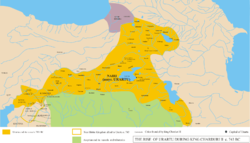 The Kingdom of Urartu during the time of Sarduris II in 743 BC.
The Kingdom of Urartu during the time of Sarduris II in 743 BC. Further information: Prehistoric Armenia
Further information: Prehistoric ArmeniaGreater Armenia lies in the highlands surrounding Mount Ararat, the highest peak of the region. In the Bronze Age, several states flourished in the area of Greater Armenia, including the Hittite Empire (at the height of its power), Mitanni (South-Western historical Armenia), and Hayasa-Azzi (1600-1200 BC). Soon after the Hayasa-Azzi were the Nairi (1400-1000 BC) and the Kingdom of Urartu (1000-600 BC), who successively established their sovereignty over the Armenian Highland. Each of the aforementioned nations and tribes participated in the ethnogenesis of the Armenian people.[23] Yerevan, the modern capital of Armenia, was founded in 782 BC by king Argishti I. A minority view also suggests that the Indo-European homeland may have been located in the Armenian Highland.[24]
Antiquity
The first state that was called Armenia by neighboring peoples (Hecataeus of Miletus and Behistun Inscription) was established in the early 6th century BC under the Orontid dynasty, which later became a kingdom. At its zenith (95–65 BC), the state extended from the Caucasus all the way to what is now central Turkey, Lebanon, and northern Iran. The imperial reign of Tigranes the Great is thus the span of time during which Armenia itself conquered areas populated by other peoples. Later it briefly became part of the Roman Empire (AD 114–118).
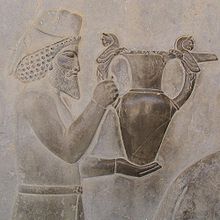 An early 5th century BC relief of an Armenian tribute bearer. This relief is from the eastern stairs leading to the Apadana at Persepolis.
An early 5th century BC relief of an Armenian tribute bearer. This relief is from the eastern stairs leading to the Apadana at Persepolis.
The Arsacid Kingdom of Armenia was the first state to adopt Christianity as its religion (it had formerly been adherent to Iranian and Hellenistic paganism – Zoroastrianism, the Ancient Greek religion and then the Ancient Roman religion).[25] in the early years of the 4th century, likely AD 314.[26] Later on, in order to further strengthen the Armenian national identity, Mesrop Mashtots invented the Armenian alphabet. This event ushered the Golden Age of Armenia, during which many foreign books and manuscripts were translated to Armenian by Mesrop's pupils. Armenia lost its sovereignty in 428 to the Byzantine and Persian Empires.
Middle Ages
In 885 the Armenians reestablished themselves as a sovereign entity under the leadership of Ashot I of the Bagratid Dynasty. A considerable portion of the Armenian nobility and peasantry fled the Byzantine occupation of Bagratid Armenia in 1045, and the subsequent invasion of the region by Seljuk Turks in 1064. They settled in large numbers in Cilicia, an Anatolian region where Armenians were already established as a minority since Roman times. In 1080, they founded an independent Armenian Principality then Kingdom of Cilicia, which became the focus of Armenian nationalism. The Armenians developed close social, cultural, military, and religious ties with nearby Crusader States, but eventually succumbed to the Mamluk invaders.
In the 16th century, Eastern Armenia was conquered by the Turco-Persian Safavid Empire, while Western Armenia fell under Ottoman rule. In the 1820s, parts of historic Armenia under Persian control centering on Yerevan and Lake Sevan were incorporated into the Russian Empire, but Western Armenia remained in the Ottoman Empire.
Modern history
The ethnic cleansing of Armenians during the final years of the Ottoman Empire is widely considered a genocide, an estimated 1.5 million victims, with one wave of persecution in the years 1894 to 1896 culminating in the events of the Armenian Genocide in 1915 and 1916. With World War I in progress, the Turks accused the (Christian) Armenians as liable to ally with Imperial Russia, and used it as a pretext to deal with the entire Armenian population as an enemy within their empire.
Turkish governments since that time have consistently rejected charges of genocide, typically arguing either that those Armenians who died were simply in the way of a war or that killings of Armenians were justified by their individual or collective support for the enemies of the Ottoman Empire. Passage of legislation in various foreign countries condemning the persecution of the Armenians as genocide has often provoked diplomatic conflict. (See Recognition of the Armenian Genocide)
Armenian volunteers in the ranks of the British-led Egyptian Expeditionary Force, which fought against the Ottomans in 1916-1918.
Following the breakup of the Russian Empire in the aftermath of World War I for a brief period, from 1918 to 1920, Armenia was an independent republic. In late 1920, the communists came to power following an invasion of Armenia by the Red Army, and in 1922, Armenia became part of the Transcaucasian SFSR of the Soviet Union, later forming the Armenian Soviet Socialist Republic (1936 to September 21, 1991). In 1991, Armenia declared independence from the USSR and established the second Republic of Armenia.
Geographic distribution
Armenia
Armenians have had a presence in the Armenian Highland for over four thousand years, since the time when Haik, the legendary patriarch and founder of the first Armenian nation, led them to victory over Bel of Babylon. Today, with a population of 3.5 million, they not only constitute an overwhelming majority in Armenia, but also in the disputed region of Nagorno-Karabakh. Armenians in the diaspora informally refer to them as Hayastantsis (Հայաստանցի), meaning those that are from Armenia (that is, they or their ancestors were not forced to flee in 1915). They, as well as the Armenians of Iran and Russia speak the Eastern dialect of the Armenian language. The country itself is secular as a result of Soviet domination, but most of its citizens are Apostolic Armenian Christian.
Diaspora
Main article: Armenian diasporaSmall Armenian trading communities have existed outside of Armenia for centuries. For example, a community has existed for over a millennium in the Holy Land, and one of the four quarters of the walled Old City of Jerusalem has been called the Armenian Quarter.[27] There are also remnants of formerly populous communities in India, Myanmar, South East Asia, Poland, Hungary, Bulgaria, Romania, Serbia, Ethiopia, Sudan and Egypt.
However, most Armenians have scattered throughout the world as a direct consequence of the genocide of 1915, constituting the Armenian diaspora. Armenian communities in and around the Georgian capital city of Tbilisi, in Syria and in Iran existed since antiquity.
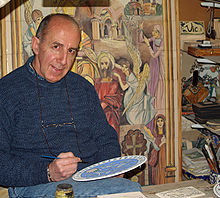 An Armenian ceramicist in the Armenian Quarter of Jerusalem.
An Armenian ceramicist in the Armenian Quarter of Jerusalem.
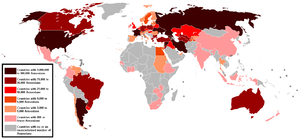 Map of the Armenian diaspora.
Map of the Armenian diaspora.
Within the diasporan Armenian community, there is an unofficial classification of the different kinds of Armenians. For example, Armenians who originate from Iran are referred to as Parskahay (Պարսկահայ), while Armenians from Lebanon are usually referred to as Lipananahay (Լիբանանահայ). Armenians of the Diaspora are the primary speakers of the Western dialect of the Armenian language. This dialect has considerable differences with Eastern Armenian, but speakers of either of the two variations can usually understand each other. Eastern Armenian in the diaspora is primarily spoken in Iran, Russia and former Soviet states such as Ukraine and Georgia (where they form a majority in the Samtskhe-Javakheti province). In diverse communities (such as in Canada and the U.S.) where many different kinds of Armenians live together, there is a tendency for the different groups to cluster together.
Religion
* An Armenian Apostolic clergyman.
* Tatev Monastery, built in the 9th century is located in the Tatev village in Syunik.Before Christianity, Armenians adhered to a syncretistic paganism: indigenous polytheism with mixed Iranian elements.[28]
In 301 AD, Armenia adopted Christianity as a state religion, becoming the first nation to do so.[19] It established a Church that still exists independently of both the Catholic and the Eastern Orthodox churches, having become so in 451 AD as a result of its excommunication by the Council of Chalcedon.[19] Today this church is known as the Armenian Apostolic Church, which is a part of the Oriental Orthodox communion, not to be confused with the Eastern Orthodox communion. During its later political eclipses, Armenia depended on the church to preserve and protect its unique identity. The original location of the Armenian Catholicosate is Echmiadzin. However, the continuous upheavals, which characterized the political scenes of Armenia, made the political power move to safer places. The Church center moved as well to different locations together with the political authority. Therefore, it eventually moved to Cilicia as the Holy See of Cilicia.[29]
The Armenians collective has, at times, constituted a Christian "island" in a mostly Muslim region. There is, however, a minuscule minority of ethnic Armenian Muslims, known as Hamshenis, while the history of the Jews in Armenia dates back 2000 years. The Armenian Kingdom of Cilicia had close ties to European Crusader States. Later on, the deteriorating situation in the region led the bishops of Armenia to elect a Catholicos in Etchmiadzin, the original seat of the Catholicosate. In 1441, a new Catholicos was elected in Etchmiadzin in the person of Kirakos Virapetsi, while Krikor Moussapegiants preserved his title as Catholicos of Cilicia. Therefore, since 1441, there have been two Catholicosates in the Armenian Church[disambiguation needed
 ] with equal rights and privileges, and with their respective jurisdictions. The primacy of honor of the Catholicosate of Etchmiadzin has always been recognized by the Catholicosate of Cilicia.[30]
] with equal rights and privileges, and with their respective jurisdictions. The primacy of honor of the Catholicosate of Etchmiadzin has always been recognized by the Catholicosate of Cilicia.[30]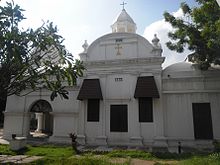 Armenian Church in Madras, India, constructed in 1712.
Armenian Church in Madras, India, constructed in 1712.
While the Armenian Apostolic Church remains the most prominent church in the Armenian community throughout the world, Armenians (especially in the diaspora) subscribe to any number of other Christian denominations. These include the Armenian Catholic Church (which follows its own liturgy but recognizes the Roman Catholic Pope), the Armenian Evangelical Church, which started as a reformation in the Mother church but later broke away, and the Armenian Brotherhood Church, which was born in the Armenian Evangelical Church, but later broke apart from it. There are other numerous Armenian churches belonging to Protestant denominations of all kinds.
Through the ages many Armenians have collectively belonged to other faiths or Christian movements, including the Paulicians which is a form of Gnostic and Manichaean Christianity. Paulicians sought to restore the pure Christianity of Paul and in c.660 founded the first congregation in Kibossa, Armenia.
Another example is the Tondrakians, who flourished in medieval Armenia between the early 9th century and 11th century. Tondrakians advocated the abolishment of the Armenian Church, denied the immortality of the soul, did not believe in an afterlife, supported property rights for peasants, and equality between men and women.
The Orthodox Armenians or the Chalcedonian Armenians in the Byzantine Impire were called Iberians ("Georgians") or "Greeks". See Gregory Pakourianos - the great Byzantine general. Some of there descendants are the Catholic Armenians in Georgia.
Culture
Language and literature
Main articles: Armenian language and Armenian literatureArmenian is a sub-branch of the Indo-European family, and with some 8 million speakers one of the smallest surviving branches, comparable to Albanian or the somewhat more widely spoken Greek, with which it may be connected (see Graeco-Armenian).
Five million Eastern Armenian speakers live in the Caucasus, Russia, and Iran, and approximately two to three million people in the rest of the Armenian diaspora speak Western Armenian. According to US Census figures, there are 300,000 Americans who speak Armenian at home. It is in fact the twentieth most commonly spoken language in the United States, having slightly fewer speakers than Haitian Creole, and slightly more than Navajo.
Armenian literature dates back to 400 AD, when Mesrob Mashdots first invented the Armenian alphabet. This period of time is often viewed as the Golden Age of Armenian literature. Early Armenian literature was written by the "father of Armenian history", Moses of Chorene, who authored The History of Armenia. The book covers the time-frame from the formation of the Armenian people to the fifth century AD. The nineteenth century beheld a great literary movement that was to give rise to modern Armenian literature. This period of time, during which Armenian culture flourished, is known as the Revival period (Zartonki sherchan). The Revivalist authors of Constantinople and Tiflis, almost identical to the Romanticists of Europe, were interested in encouraging Armenian nationalism. Most of them adopted the newly created Eastern or Western variants of the Armenian language depending on the targeted audience, and preferred them over classical Armenian (grabar). This period ended after the Hamidian massacres, when Armenians experienced turbulent times. As Armenian history of the 1920s and of the Genocide came to be more openly discussed, writers like Paruyr Sevak, Gevork Emin, Silva Kaputikyan and Hovhannes Shiraz began a new era of literature.
Architecture
Main article: Armenian architectureThe first Armenian churches were built on the orders of St. Gregory the Illuminator, and were often built on top of pagan temples, and imitated some aspects of Armenian pre-Christian architecture.[31]
Classical and Medieval Armenian Architecture is divided into four separate periods.
The first Armenian churches were built between the 4th and 7th century, beginning when Armenia converted to Christianity, and ending with the Arab invasion of Armenia. The early churches were mostly simple basilicas, but some with side apses. By the fifth century the typical cupola cone in the center had become widely used. By the seventh century, centrally-planned churches had been built and a more complicated niched buttress and radiating Hrip'simé style had formed. By the time of the Arab invasion, most of what we now know as classical Armenian architecture had formed.
From the 9th to 11th century, Armenian architecture underwent a revival under the patronage of the Bagratid Dynasty with a great deal of building done in the area of Lake Van, this included both traditional styles and new innovations. Ornately carved Armenian Khachkars were developed during this time.[32] Many new cities and churches were built during this time, including a new capital at Lake Van and a new Cathedral on Akdamar Island to match. The Cathedral of Ani was also completed during this dynasty. It wad during this time that the first major monasteries, such as Haghpat and Haritchavank were built. This period was ended by the Seljuk invasion.
Science
Main article: List of Armenians#ScienceThere are many prominent names in the world of science that are of Armenian descent.[33]
Sports
Main article: Sport in ArmeniaMany types of sports are played in Armenia, among the most popular being football, chess, boxing, basketball, hockey, sambo, wrestling, weightlifting and volleyball.[34] Since independence, the Armenian government has been actively rebuilding its sports program in the country.
During Soviet rule, Armenian athletes rose to prominence winning plenty of medals and helping the USSR win the medal standings at the Olympics on numerous occasions. The first medal won by an Armenian in modern Olympic history was by Hrant Shahinian, who won two golds and two silvers in gymnastics at the 1952 Summer Olympics in Helsinki. In football, their most successful team was Yerevan's FC Ararat, which had claimed most of the Soviet championships in the 70s and had also gone to post victories against professional clubs like FC Bayern Munich in the Euro cup.
Armenians have also been successful in chess, which is the most popular mind sport in Armenia. Some of the most prominent chess players in the world are Armenian such as Tigran Petrosian, Levon Aronian and Garry Kasparov. Armenians have also been successful in weightlifting and wrestling, winning medals in each sport at the Olympics.
Music and dance
Main articles: Music of Armenia and Armenian DanceArmenian music is a mix of indigenous folk music, perhaps best-represented by Djivan Gasparyan's well-known duduk music, as well as light pop, and extensive Christian music.
Instruments like the duduk, the dhol, the zurna and the kanun are commonly found in Armenian folk music. Artists such as Sayat Nova are famous due to their influence in the development of Armenian folk music. One of the oldest types of Armenian music is the Armenian chant which is the most common kind of religious music in Armenia. Many of these chants are ancient in origin, extending to pre-Christian times, while others are relatively modern, including several composed by Saint Mesrop Mashtots, the inventor of the Armenian alphabet. Whilst under Soviet rule, Armenian classical music composer Aram Khatchaturian became internationally well known for his music, for various ballets and the Sabre Dance from his composition for the ballet Gayane.
The Armenian Genocide caused widespread emigration that led to the settlement of Armenians in various countries in the world. Armenians kept to their traditions and certain diasporans rose to fame with their music. In the post-Genocide Armenian community of the United States, the so called "kef" style Armenian dance music, using Armenian and Middle Eastern folk instruments (often electrified/amplified) and some western instruments, was popular. This style preserved the folk songs and dances of Western Armenia, and many artists also played the contemporary popular songs of Turkey and other Middle Eastern countries from which the Armenians emigrated. Richard Hagopian is perhaps the most famous artist of the traditional "kef" style and the Vosbikian Band was notable in the 40s and 50s for developing their own style of "kef music" heavily influenced by the popular American Big Band Jazz of the time. Later, stemming from the Middle Eastern Armenian diaspora and influenced by Continental European (especially French) pop music, the Armenian pop music genre grew to fame in the 60s and 70s with artists such as Adiss Harmandian and Harout Pamboukjian performing to the Armenian diaspora and Armenia. Also with artists such as Sirusho, performing pop music combined with Armenian folk music in today's entertainment industry. Other Armenian diasporans that rose to fame in classical or international music circles are world renown French-Armenian singer and composer Charles Aznavour, pianist Sahan Arzruni, prominent opera sopranos such as Hasmik Papian and more recently Isabel Bayrakdarian and Anna Kasyan. Certain Armenians settled to sing non-Armenian tunes such as the heavy metal band System of a Down (which nonetheless often incorporates traditional Armenian instrumentals and styling into their songs) or pop star Cher. In the Armenian diaspora, Armenian revolutionary songs are popular with the youth. These songs encourage Armenian patriotism and are generally about Armenian history and national heroes.
Carpet weaving
See also: Armenian carpetCarpet-weaving is historically a major traditional profession for the majority of Armenian women, including many Armenian families. Prominent Karabakh carpet weavers there were men too. The oldest extant Armenian carpet from the region, referred to as Artsakh (see also Karabakh carpet) during the medieval era, is from the village of Banants (near Gandzak) and dates to the early 13th century.[35] The first time that the Armenian word for carpet, gorg, was used in historical sources was in a 1242-1243 Armenian inscription on the wall of the Kaptavan Church in Artsakh.[36]
Art historian Hravard Hakobyan notes that "Artsakh carpets occupy a special place in the history of Armenian carpet-making."[36] Common themes and patterns found on Armenian carpets were the depiction of dragons and eagles. They were diverse in style, rich in color and ornamental motifs, and were even separated in categories depending on what sort of animals were depicted on them, such as artsvagorgs (eagle-carpets), vishapagorgs (dragon-carpets) and otsagorgs (serpent-carpets).[36] The rug mentioned in the Kaptavan inscriptions is composed of three arches, "covered with vegatative ornaments", and bears an artistic resemblance to the illuminated manuscripts produced in Artsakh.[36]
The art of carpet weaving was in addition intimately connected to the making of curtains as evidenced in a passage by Kirakos Gandzaketsi, a 13th century Armenian historian from Artsakh, who praised Arzu-Khatun, the wife of regional prince Vakhtang Khachenatsi, and her daughters for their expertise and skill in weaving.[37]
Armenian carpets were also renowned by foreigners who traveled to Artsakh; the Arab geographer and historian Al-Masudi noted that, among other works of art, he had never seen such carpets elsewhere in his life.[38]
Cuisine
Main article: Armenian cuisineArmenians enjoy many different native and foreign foods. The most popular food is khorovats an Armenian-styled barbecue, which is famous worldwide. Lavash is a very popular Armenian rollable bread, and Armenian baklava is a special treat. Other famous Armenian foods include the kabob (a skewer of marinated roasted meat and vegetables), t'pov dolma (minced lamb,or beef meat and rice wrapped in grape leaves), kaghambi dolma (minced meat and rice wrapped in cabbage), amarayin dolma (cored tomatoes, eggplants and green peppers stuffed with minced mixed meats and rice), and pilaf, a tasty rice dish. Also, Ghapama,a rice dish, and many different salads are popular in Armenian culture. Fruits play a large part in the Armenian diet. Apricots (also known as Armenian Plum) native to this area and have really unique taste, peaches are native too and are very popular; also common are grapes, figs, pomegranates, and melons.
Genetics
The geographical distribution of the R1b haplotype is such that it is shared by Armenians and two other populations from the Caucasus.[39]
Institutions
The nation-state of Armenia is the most prominent Armenian institution today. Other important institutions include:
- The Armenian Apostolic Church
- The Armenian Catholic Church
- The Armenian Evangelical Church The community was formally recognized in 1846 by the Ottoman Empire.
- The Armenian General Benevolent Union (AGBU) founded in 1906 and the largest Armenian non-profit organization in the world with educational, cultural and humanitarian projects on six continents.
- The Armenian Revolutionary Federation was founded in 1890. It is generally referred to as the Dashnaktsutyun, which means Federation in Armenian. The ARF is the strongest worldwide Armenian political organization and the only diasporan Armenian organization with a significant political presence in the Republic of Armenia.
- The Armenian Relief Society, founded in 1910.
- Hamazkayin, an Armenian cultural and educational society founded in Cairo in 1928, and responsible for the founding of Armenian secondary schools and institutions of higher education in several countries.
- Homenetmen, an Armenian scouting and athletic organization founded in 1910 with a worldwide membership of about 25,000.
See also
Notes
- ^ a b 2001 Official Armenian Census statistics. Archived 30 January 2010 at WebCite
- ^ a b c d e f Astourian, Stephan H. (2007). "Armenian Demography, the Homeland, and the Diaspora: Trends and Consequences". In ed. Michel Bruneau. Arméniens et grecs en diaspora: approches comparatives. Athens: École française d’Athènes. pp. 191-210. OCLC 173263899.
- ^ a b c d e f http://www.armeniadiaspora.com/population.html
- ^ Official Statistics of the NKR. Official site of the President of the NKR. Archived 11 February 2011 at WebCite
- ^ a b The Population of Azerbaijan
- ^ The Encyclopedia of the Orient states that 160,000 Apostolic Armenians and 30,000 Catholic Armenians live in Syria. That number together makes up 190,000. Archived 11 February 2011 at WebCite
- ^ joshuaproject.net TU Archived 11 February 2011 at WebCite
- ^ 2002 Official Russian Census population statistics. Archived 11 February 2011 at WebCite
- ^ The Education for Development Institute maintains an extensive site about Armenia that includes information about the Armenian diaspora in various countries. Their numbers generally agree with other sources when those are available; where we don’t have a more authoritative source, we are following their numbers. Archived 11 February 2011 at WebCite
- ^ "French in Armenia 'genocide' row". BBC News. 2006-10-12. Archived from the original on 2011-02-11. http://news.bbc.co.uk/2/hi/europe/6043730.stm. Retrieved 2007-04-21.
- ^ Official site of the Armenian Community of Greece
- ^ American Community Survey 2009 statistics. Archived 11 February 2011 at WebCite
- ^ Bert Vaux, Hemshinli: The Forgotten Black Sea Armenians, Harvard University, 2001 p.1
- ^ Andrews. Ethnic Groups in the Republic of Turkey, pp. 476-477, 484, 487.
- ^ Hagopian. "Notes", pp. 159, 165, 176.
- ^ Vaux, Bert. "Homshetsma: The Language of the Armenians of Hamshen", in The Hemshen, p. 257.
- ^ Ersoy, Erhan Gürsel. "The Hemshin People: Ethnic Identity, Beliefs, and Yayla Festivals in Çamlıhemşin", in The Hemshin pp. 332, 333.
- ^ "500,000 “hidden” Armenians in Turkey?". Archived from the original on 2011-02-11. http://news.am/eng/news/32050.html. Retrieved 2010-09-24.
- ^ a b c see Hastings, Adrian (2000). A World History of Christianity. Wm. B. Eerdmans Publishing. p. 289. ISBN 978-0-8028-4875-8.
- ^ "Armenia first nation to adopt Christianity as a state religion.". Archived from the original on 2011-02-11. http://www.ncccusa.org/news/01news36a.html. Retrieved 2007-02-27.
- ^ "Haik and Hayastan". Archived from the original on 2011-02-11. http://www.ezilon.com/about-armenia.htm. Retrieved 2007-03-04.
- ^ "Armenia Provinces". Archived from the original on 2011-02-11. http://www.statoids.com/uam.html. Retrieved 2007-03-04.
- ^ Vahan Kurkjian, "History of Armenia", Michigan, 1968, History of Armenia by Vahan Kurkjian; Armenian Soviet Encyclopedia, v. 12, Yerevan 1987; Artak Movsisyan, "Sacred Highland: Armenia in the spiritual conception of the Near East", Yerevan, 2000; Martiros Kavoukjian, "The Genesis of Armenian People", Montreal, 1982
- ^ Thomas Gamkrelidze and Vyacheslav V. Ivanov , The Early History of Indo-European Languages, March 1990, P.110
- ^ "The conversion of Armenia to Christianity was probably the most crucial step in its history. It turned Armenia sharply away from its Iranian past and stamped it for centuries with an intrinsic character as clear to the native population as to those outside its borders, who identified Armenia almost at once as the first state to adopt Christianity". (Nina Garsoïan in Armenian People from Ancient to Modern Times, ed. R.G. Hovannisian, Palgrave Macmillan, 1997, Volume 1, p.81).
- ^ traditionally dated to 301 following Mikayel Chamchian (1784). 314 is the date favoured by mainstream scholarship, so Nicholas Adontz (1970), p.82, following the research of Ananian, and Seibt The Christianization of Caucasus (Armenia, Georgia, Albania) (2002).
- ^ "Armenian Quarter in Jerusalem". http://www.holyland.org/. Retrieved 2007-02-27.
- ^ The Cambridge Ancient History. vol. 12, p. 486. London: Cambridge University Press, 2005.
- ^ "A Migrating Catholicosate". http://www.armenianprelacy.ca/history2.htm. Retrieved 2007-02-27.
- ^ "Two Catholicosates within the Armenian Church". http://www.armenianprelacy.ca/history3.htm. Retrieved 2007-02-27.
- ^ Sacred Geometry and Armenian Architecture | Armenia Travel, History, Archeology & Ecology | TourArmenia | Travel Guide to Armenia
- ^ Armenia, Past and Present; Elisabeth Bauer, Jacob Schmidheiny, Frederick Leist , 1981
- ^ From Metsamor Upward: A look back at space-minded Armenians – Features | ArmeniaNow.com
- ^ "Sport in Armenia". http://www.worldinfozone.com/country.php?country=Armenia&page=2. Retrieved 2007-02-27.
- ^ Hakobyan, Hravard H (1990). The Medieval Art of Artsakh. Yerevan, Armenian SSR: Parberakan. p. 84. ISBN 978-5-8079-0195-8.
- ^ a b c d Hakobyan. Medieval Art of Artsakh, p. 84.
- ^ (Armenian) Kirakos Gandzaketsi. Պատմություն Հայոց (History of Armenia). Yerevan, Armenian SSR: Armenian Academy of Sciences, 1961, p. 216, as cited in Hakobyan. Medieval Art of Artsakh, p. 84, note 18.
- ^ (Armenian) Ulubabyan, Bagrat A (1975). Խաչենի իշխանությունը, X-XVI դարերում (The Principality of Khachen, From the 10th to 16th Centuries). Yerevan, Armenian SSR: Armenian Academy of Sciences. p. 267.
- ^ Flemish DNA and Ancestry: History of Three Families Over Five Centuries ... - Page 261 by Guido Deboeck
References
 This article incorporates public domain material from websites or documents of the CIA World Factbook.
This article incorporates public domain material from websites or documents of the CIA World Factbook. This article incorporates public domain material from websites or documents of the United States Department of State (Background Notes).
This article incorporates public domain material from websites or documents of the United States Department of State (Background Notes).- The categorization of Armenian churches in Los Angeles used information from Sacred Transformation: Armenian Churches in Los Angeles a project of the USC School of Policy, Planning, and Development.
- Some of the information about the history of the Armenians comes from the multi-volume History of the Armenian People, Yerevan, Armenia, 1971.
Further reading
- George A. Bournoutian, A History of the Armenian People, 2 vol. (1994)
- George A. Bournoutian, A Concise History of the Armenian People (Mazda, 2003, 2004).
- Hovannisian, Richard G., ed. (September 1997) The Armenian People From Ancient to Modern Times Volume I - The Dynastic Periods: From Antiquity to the Fourteenth Century New York: St. Martin's Press ISBN 0-312-10169-4
- Hovannisian, Richard G., ed. (September 1997) The Armenian People From Ancient to Modern Times Volume II - Foreign Dominion to Statehood: The Fifteenth Century to the Twentieth Century New York: St. Martin's Press ISBN 0-312-10168-6
- I. M. Diakonoff, The Pre-History of the Armenian People (revised, trans. Lori Jennings), Caravan Books, New York (1984), ISBN 978-0-88206-039-2.
- Redgate, Anne Elizabeth (1999), The Armenians (1st ed.), Oxford, UK: Blackwell Publishers, ISBN 0-631-22037-2
- Russell D. Gray and Quentin D. Atkinson, "Language-tree divergence times support the Anatolian theory of Indo-European origin", Nature, 426, 435-439 (2003)
UCLA conference series proceedings
The UCLA conference series titled "Historic Armenian Cities and Provinces" is organized by the Holder of the Armenian Educational Foundation Chair in Modern Armenian History. The conference proceedings are edited by Richard G. Hovannisian. Published in Costa Mesa, CA, by Mazda Publishers, they are:
- Armenian Van/Vaspurakan (2000) OCLC 44774992
- Armenian Baghesh/Bitlis and Taron/Mush (2001) OCLC 48223061
- Armenian Tsopk/Kharpert (2002) OCLC 50478560
- Armenian Karin/Erzerum (2003) OCLC 52540130
- Armenian Sebastia/Sivas and Lesser Armenia (2004) OCLC 56414051
- Armenian Tigranakert/Diarbekir and Edessa/Urfa (2006) OCLC 67361643
- Armenian Cilicia (2008) OCLC 185095701
- Armenian Pontus: the Trebizond-Black Sea communities (2009) OCLC 272307784
External links
- FACES Project – Armenian population worldwide
- Armenian Videos from Armenia and Diaspora
- A long way from Ararat... Little Armenias int Europe and the Mediterranean. Marseille's Armenians
 Armenia topics
Armenia topicsHistory (timeline) EarlyOrigins · Name · Kura-Araxes culture · Hayk · Hayasa-Azzi · Mitanni · Nairi · Kingdom of Urartu · Orontid dynasty · Kingdom of Armenia · Roman Armenia · Byzantine Armenia · Bagratuni Armenia · Armenian Kingdom of CiliciaMiddleModernBy topicGovernment and
politicsConstitution · President · Prime Minister · National Assembly · Political parties · Elections · Foreign relations · Corruption · Human rights · LGBT rights · Relations with the European Union · more on government / politicsEconomy Armenian dram · Central Bank · List of companies · Armex · Agriculture · Industry · Communications · Transport · Energy · Mining · Waste management · International rankingsAdministrative
divisionsArmed Forces Geography Demographics People · Diaspora · Census · Health · Crime · Education · Social issues · Ethnic minorities · Women · moreReligion Culture Symbols Armenian diaspora Armenian populations by countryFormer Soviet Union Azerbaijan (Nakhichevan) · Belarus · Estonia · Georgia (Abkhazia / Javakheti / Tbilisi) · Kazakhstan · Kyrgyzstan · Latvia · Lithuania · Moldova · Russia · Tajikistan · Turkmenistan · Ukraine (Crimea) · UzbekistanAmericas Europe Middle East Asia Africa Oceania Eastern and Oriental Orthodox Christian Ethnic Groups Majority EuropeanArmenians · Aromanians · Belarusians · Bulgarians · Georgians · Greeks (including Greek Cypriots) · Macedonians · Megleno-Romanians · Moldovans · Montenegrins · Ossetians · Romanians · Russians · Serbs · UkrainiansAfro-AsiaticAltaicUralicChukotko-KamchatkanMinority Categories:- Armenian people
- Ancient peoples
- Armenian society
- Caucasian muhajirs
- Ethnic groups in Europe
- Ethnic groups in the Middle East
- Ethnic groups in France
- Ethnic groups in Georgia (country)
- Ethnic groups in Iran
- Ethnic groups in Lebanon
- Ethnic groups in Russia
- Ethnic groups in Turkey
- Ethnic groups in Ukraine
- Ethnic groups in Azerbaijan
- Ethnic groups in the Arab League
- Indo-European peoples
- Peoples of the Caucasus
Wikimedia Foundation. 2010.

